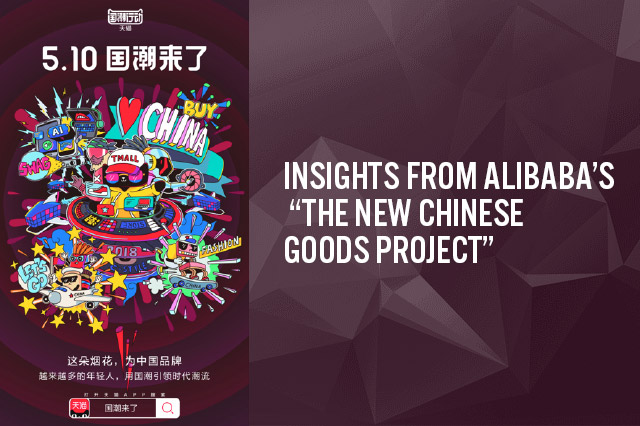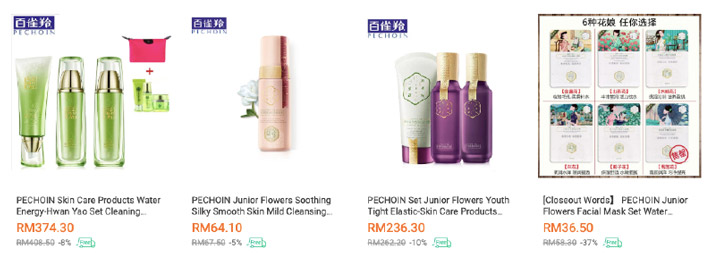
DIpil Das
1. Five Goals of Empowering “The New Chinese Goods” and Cross-Border Sales
On May 8, Alibaba held a launch event for “The New Chinese Goods Project”. Alibaba believes that in the new digital era, “the new Chinese goods” refers to any China homegrown brands, China-made goods, and China-innovated goods.
Alibaba has established five main objectives:
 Chinese skincare brand Unifon is selling on AliExpress
Chinese skincare brand Unifon is selling on AliExpress
Source: aliexpress.com [/caption] Starting in April, Alibaba-owned Lazada, the largest e-commerce platform in Southeast Asia, simplified the process for Chinese merchants to sell overseas. Cross-border sellers no longer need an invitation to sell goods on the platform but can submit applications using a self-service system. Once the review is completed, they can become Lazada merchants. [caption id="attachment_87562" align="aligncenter" width="720"] Unifon is selling on Lazada
Unifon is selling on Lazada
Source: lazada.com.my [/caption] [caption id="attachment_87563" align="aligncenter" width="720"] Chinese skincare brand Pechoin is selling on Lazada
Chinese skincare brand Pechoin is selling on Lazada
Source: lazada.com.my [/caption] 2. The “Old” Chinese Brands Are Growing Fast Alibaba defines “traditional” Chinese brands as “intangible cultural heritage brands” or “time-honored brands”. According to Alibaba, among the total of 1,128 China’s “time-honored brands”, 70% have opened stores on Tmall or Taobao. And 46 of those brands have had sales over 100 million purchase orders in 2018. The “intangible cultural heritage brands” include more than 10 Chinese cultural institutions including the Palace Museum (Forbidden City), whose brand has launched several products including lipstick. [caption id="attachment_87564" align="aligncenter" width="720"] Tmall China Wave Promotion and Palace Museum Lipstick
Tmall China Wave Promotion and Palace Museum Lipstick
Source: Tmall [/caption] Meanwhile, traditional brands are adapting to the trends and needs of the younger generation. Many young consumers are seeking more unique, character-driven and identifiable design. Some Chinese brands have incorporated modern aesthetic elements into their culturally rich brand design; other Chinese brands are aiming to be trendy and have an international focus — for example, Li Ning appearing in international fashion shows and winning international recognition. This has brought huge success and attraction to young consumers esp. those born in the 1990s and 2000s. [caption id="attachment_87565" align="aligncenter" width="720"] Li Ning show in NY Fashion Week
Li Ning show in NY Fashion Week
Source: NYFWChinaDay.com [/caption] 3. The Young Become the Main Consumption Force of New Chinese Goods According to Alibaba, nearly 80% of Chinese brands are purchased by those born in the 1980s and 1990s. In 2018, among all purchase orders of Chinese brands, 39% were made from those born in the 1980s and 32% from those born in the 1990s. Even those born in the 2000s are becoming a major consumption force. As the 2018 Chinese Digital Economy Development Report shows, the consumption power of those born in the 2000s are growing by 190%. And half of them believe Chinese goods are just as good as international ones.
- Help the digital upgrade of 1,000 industrial clusters.
- Build 200 Chinese brands that each generate ¥1 billion sales.
- Support 200 traditional time-honored brands to achieve ¥100 million sales each.
- Help 200,000 Taobao creative specialty stores to achieve ¥5 million sales each.
- Help 700,000 Chinese brands to sell overseas through Tmall Global, Lazada and AliExpress.
 Chinese skincare brand Unifon is selling on AliExpress
Chinese skincare brand Unifon is selling on AliExpress Source: aliexpress.com [/caption] Starting in April, Alibaba-owned Lazada, the largest e-commerce platform in Southeast Asia, simplified the process for Chinese merchants to sell overseas. Cross-border sellers no longer need an invitation to sell goods on the platform but can submit applications using a self-service system. Once the review is completed, they can become Lazada merchants. [caption id="attachment_87562" align="aligncenter" width="720"]
 Unifon is selling on Lazada
Unifon is selling on Lazada Source: lazada.com.my [/caption] [caption id="attachment_87563" align="aligncenter" width="720"]
 Chinese skincare brand Pechoin is selling on Lazada
Chinese skincare brand Pechoin is selling on Lazada Source: lazada.com.my [/caption] 2. The “Old” Chinese Brands Are Growing Fast Alibaba defines “traditional” Chinese brands as “intangible cultural heritage brands” or “time-honored brands”. According to Alibaba, among the total of 1,128 China’s “time-honored brands”, 70% have opened stores on Tmall or Taobao. And 46 of those brands have had sales over 100 million purchase orders in 2018. The “intangible cultural heritage brands” include more than 10 Chinese cultural institutions including the Palace Museum (Forbidden City), whose brand has launched several products including lipstick. [caption id="attachment_87564" align="aligncenter" width="720"]
 Tmall China Wave Promotion and Palace Museum Lipstick
Tmall China Wave Promotion and Palace Museum Lipstick Source: Tmall [/caption] Meanwhile, traditional brands are adapting to the trends and needs of the younger generation. Many young consumers are seeking more unique, character-driven and identifiable design. Some Chinese brands have incorporated modern aesthetic elements into their culturally rich brand design; other Chinese brands are aiming to be trendy and have an international focus — for example, Li Ning appearing in international fashion shows and winning international recognition. This has brought huge success and attraction to young consumers esp. those born in the 1990s and 2000s. [caption id="attachment_87565" align="aligncenter" width="720"]
 Li Ning show in NY Fashion Week
Li Ning show in NY Fashion Week Source: NYFWChinaDay.com [/caption] 3. The Young Become the Main Consumption Force of New Chinese Goods According to Alibaba, nearly 80% of Chinese brands are purchased by those born in the 1980s and 1990s. In 2018, among all purchase orders of Chinese brands, 39% were made from those born in the 1980s and 32% from those born in the 1990s. Even those born in the 2000s are becoming a major consumption force. As the 2018 Chinese Digital Economy Development Report shows, the consumption power of those born in the 2000s are growing by 190%. And half of them believe Chinese goods are just as good as international ones.